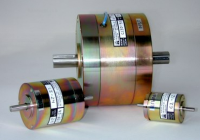








A magnetic particle clutch is a special type of electromagnetic clutch which does not use friction plates,patented by Jacob Rainbow. Instead, it uses a fine powder of magnetically susceptible material (typically stainless steel) to mechanically link an otherwise free wheeling disc attached to one shaft, to a rotor attached to the other shaft.
Principle
This clutch is a form of powder clutch. Torque is transmitted mechanically, through a metal powder filling. In the magnetically controlled version, an applied magnetic field is used to lock the particles in place. Unlike a pure magnetic coupling though, this field takes no part in transmitting torque magnetically.
When a magnetic field is applied to the powder, it forms chains connecting the disc and rotor. The strength of the chains depends on the strength of the magnetic field.
Jacob Rabinow
During this time, Rabinow invented and patented a number of revolutionary devices. Among them are the first disc-shaped magnetic storage media for computers (1954), the magnetic particle clutch (1956), the first straight-line phonograph (1959), the first self-regulating clock (1960) and his famous "reading machine" (1960) which was the first to use the "best match" principle and was the basis for the reading, sorting and processing machines used today by banks and post offices.